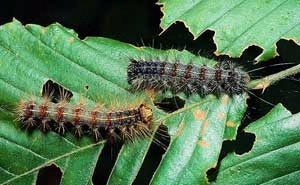Posts Tagged: gypsy moth
CDFA decides to try gypsy moth eradication in Ventura
The California Department of Food and Agriculture has decided to spray a natural pesticide commonly used on organic farms in the Ventura County community of Ojai to knock down a local infestation of gypsy moths, according to an article in the Ventura County Star.
The gypsy moth was deliberately introduced into the United States in 1868 by French scientist Leopold Trouvelot, who wanted to breed a disease-resistant, silk-spinning hybrid caterpillar. Some moths escaped from his Massachusetts lab and the insect became a notorious pest of hardwood trees in the eastern United States, according to a Wikipedia article on the moth.
Four gypsy moths were trapped in Ojai in June 2007; 15 months later, CDFA placed a five-acre area under quarantine. Among other trees, gypsy moths' presence in Ventura County threatens California native oaks. Star reporter Stephanie Hoops contacted UC Cooperative Extension farm advisor Ben Faber for information about CDFA's planned eradication program.
Faber told the reporter that the pesticide to be used, bacillus thuringiensis kurstaki, is safe and a good way to stop the gypsy moth from defoliating oak trees.
“The thought of our hillsides without oaks is scary,” Faber was quoted. “I hope people would consider the ecological consequences if we let the gypsy moths get away.”

Gypsy moth larvae